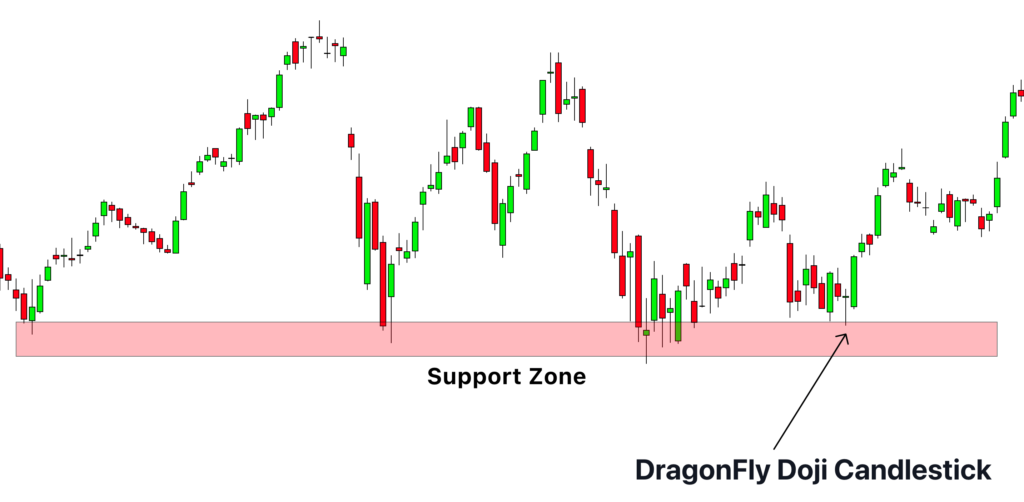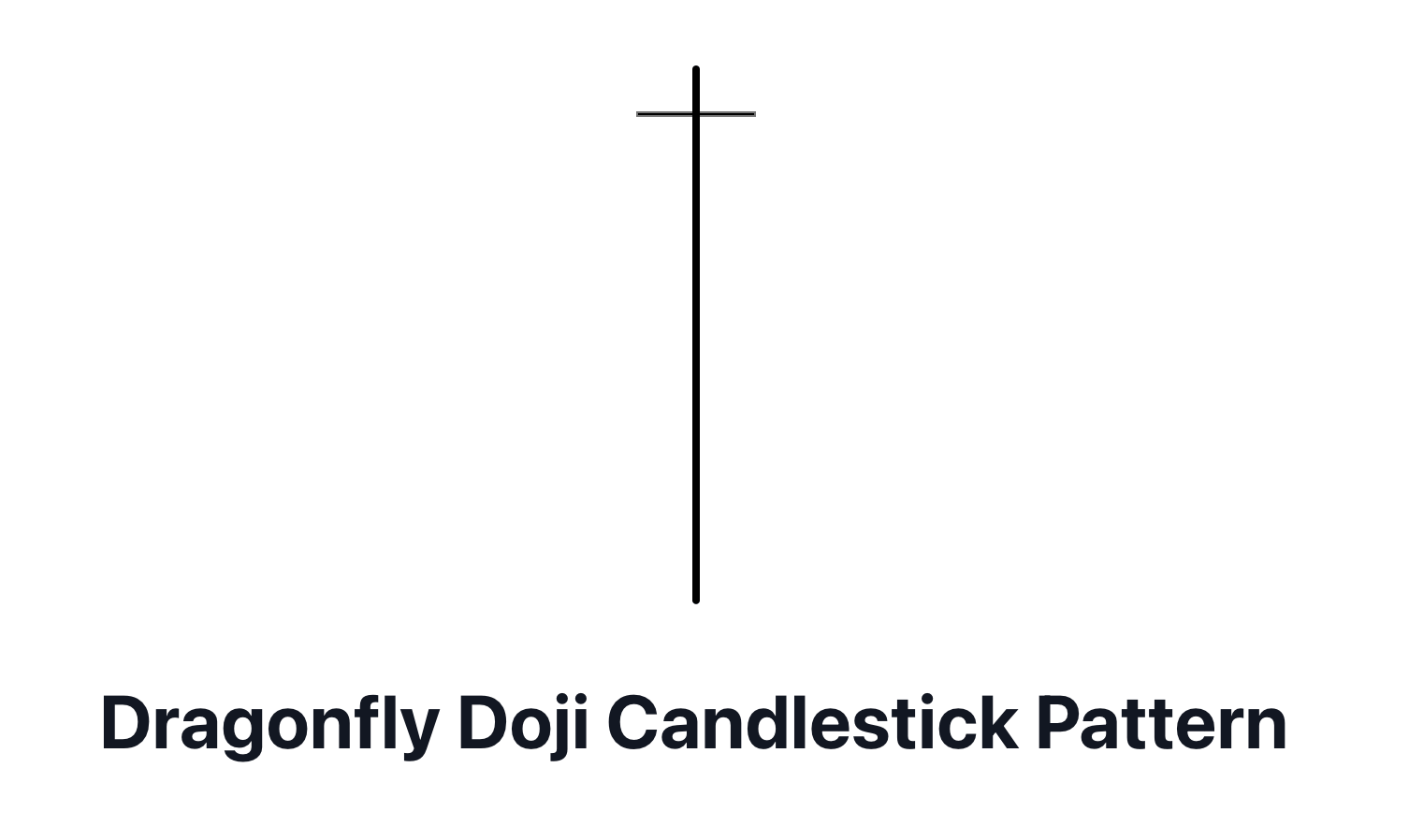Definition
The Dragonfly Doji is a candlestick pattern characterized by a long lower wick and virtually no upper wick or body, suggesting a strong bullish reversal after a downtrend.
This unique pattern, named for its resemblance to a dragonfly, signals that despite initial selling pressure during a session, buying pressure overwhelmed the sellers and pushed the price back to its open, indicating potential future bullish momentum.
How to identify the Dragonfly Doji Candlestick Pattern?
To identify a Dragonfly Doji on a trading chart, traders can look for the following features:
- Market Context: The Dragonfly Doji often appears after a bearish (downward) trend, indicating a potential reversal.
- Small or No Body: The Dragonfly Doji candlestick has a very small or no body. It’s almost a line.
- Long Lower Wick: There is a long lower wick, which is typically two to three times the length of the body.
- No Upper Wick: There is virtually no upper wick, signifying that buyers were able to push the price up to the opening price by the close.
- Color: The color of the Dragonfly Doji can be either green or red, but a green (bullish) Dragonfly Doji is considered more bullish.

Significance
The Dragonfly Doji is a significant candlestick pattern that often suggests a bullish reversal. This pattern indicates that, despite considerable selling pressure during the trading period, buyers were able to push the price back to the opening level, demonstrating their strength and potential to drive a reversal of the prior bearish trend. It suggests that the market is rejecting lower prices and that the bulls are gaining momentum.
For the pattern to be valid, it’s essential to see a confirmation candle following the Dragonfly Doji, indicating a continuation of the newfound bullish sentiment. This is usually seen as a bullish candlestick that closes above the high of the Dragonfly Doji.
Psychology behind the dragonfly doji candlestick pattern
When a Dragonfly Doji pattern appears on the chart, it often suggests that the larger market participants are stepping in to support the price, hence preventing it from falling further. The creation of this pattern indicates a period where the big traders, or “smart money”, have started to buy into the market, absorbing the selling pressure.
During the formation of the Dragonfly Doji, the price falls significantly after the open, indicating strong selling activity. However, by the close of the period, the price has returned to the opening level, showing that buyers (likely led by big traders) have successfully countered the sellers and potentially indicating a change in market sentiment.
For retail traders, it’s a valuable clue that the balance might be shifting from sellers to buyers. If this pattern forms at a significant support level or after a protracted downtrend, it may offer an even stronger signal of potential bullish reversal, as it signifies a rejection of lower prices by the market’s larger players.
Find high probability Dragonfly Doji pattern
| Confirmation Tool | Description |
|---|---|
| Key Support Level | Spotting a Dragonfly Doji at a key support level can strengthen the potential reversal signal, as it shows the price is being rejected at a historically significant level. |
| Volume | An increase in trading volume during the formation of the Dragonfly Doji provides further confirmation of the pattern. Higher volume shows increased activity and interest at the current price level. |
| Oversold Indicator | If an oscillator like RSI or Stochastic indicates that the market is oversold at the same time the Dragonfly Doji forms, this could provide additional confirmation of a potential upward reversal. |
| Follow-up Candle | The next candle after the Dragonfly Doji should ideally be a bullish candle. The break of its high can confirm the reversal signal and provide a potential entry point for a long trade. |
Key Points
- Best Timeframe: The Dragonfly Doji is more effective in higher timeframes due to the higher reliability of data. Ideally, it should be observed on the 1-hour chart or above, with the daily chart providing some of the most reliable signals.
- Trading Session: This pattern can be identified in any trading session including the New York, London, and Asian sessions. However, it’s critical to understand the overall market context, as session opens and closes can often produce price volatility.
- Winning Ratio: A rough estimate for the winning ratio of this pattern, provided it is confirmed with additional factors, could be around 60-65%.
Trading Strategy for Dragonfly Doji
- Key Level Confluence: First, identify the key levels of support and resistance. Look for the Dragonfly Doji forming near these levels, ideally at a significant support level.
- Entry Point: The ideal entry point would be at the opening of the next candle after the Dragonfly Doji. The long lower shadow indicates that sellers were overcome by buyers, which can often lead to a reversal in price. Therefore, initiating a long position here could be advantageous.
- Stop-Loss: Your stop loss should be set just below the low of the Dragonfly Doji. This means if the price falls below this level, the trade is automatically closed to limit losses.
- Take-Profit Level: Set your take profit at the next significant resistance level. The aim here is to take advantage of the potential upward trend initiated by the Dragonfly Doji.

Conclusion
The Dragonfly Doji is a potent bullish reversal signal that often indicates a turning point in the market. Traders should not only watch for this pattern but also ensure that it has proper confirmations from key levels or other technical tools to increase the probability of successful trades. As always, proper risk management should be employed when trading.


